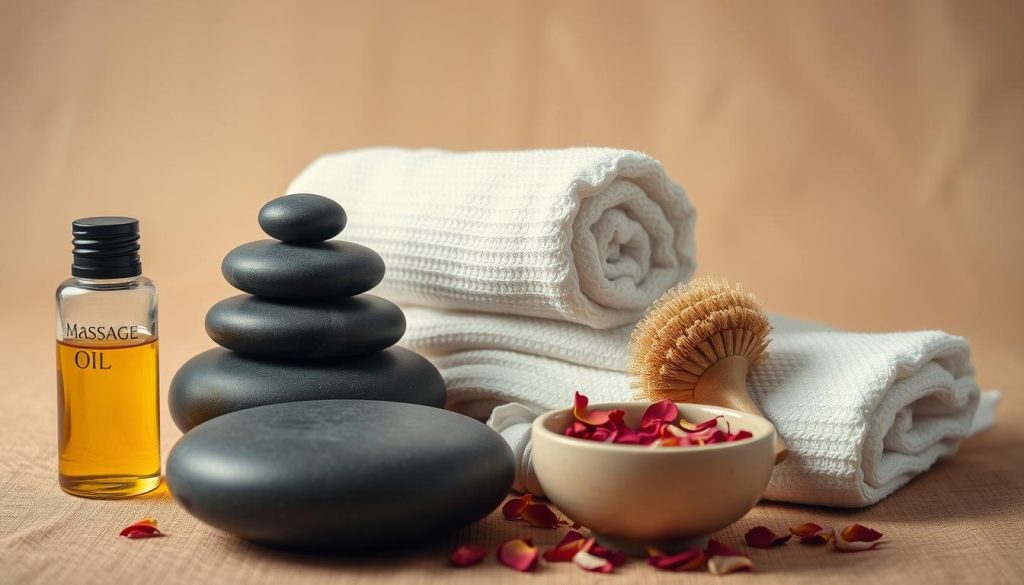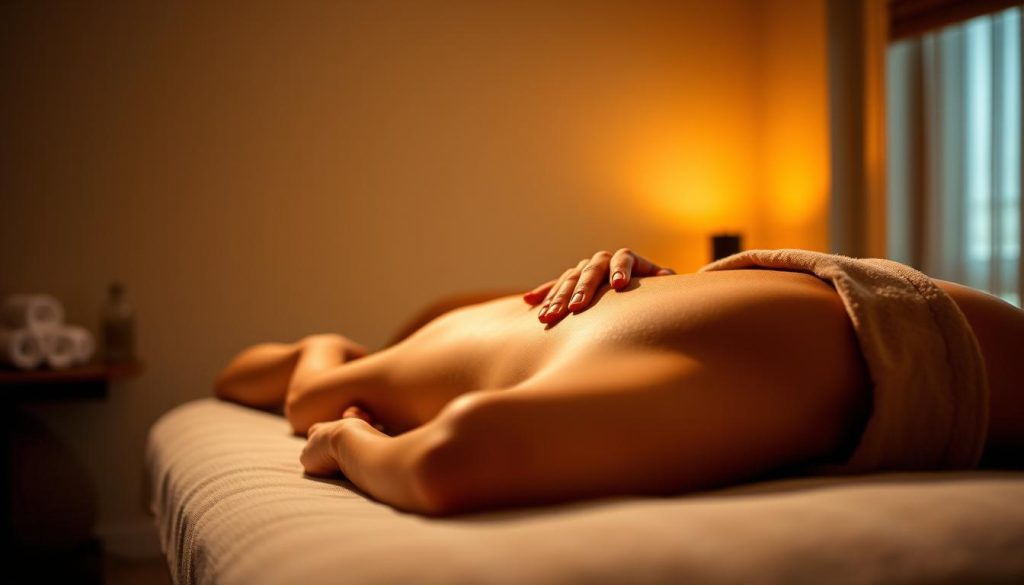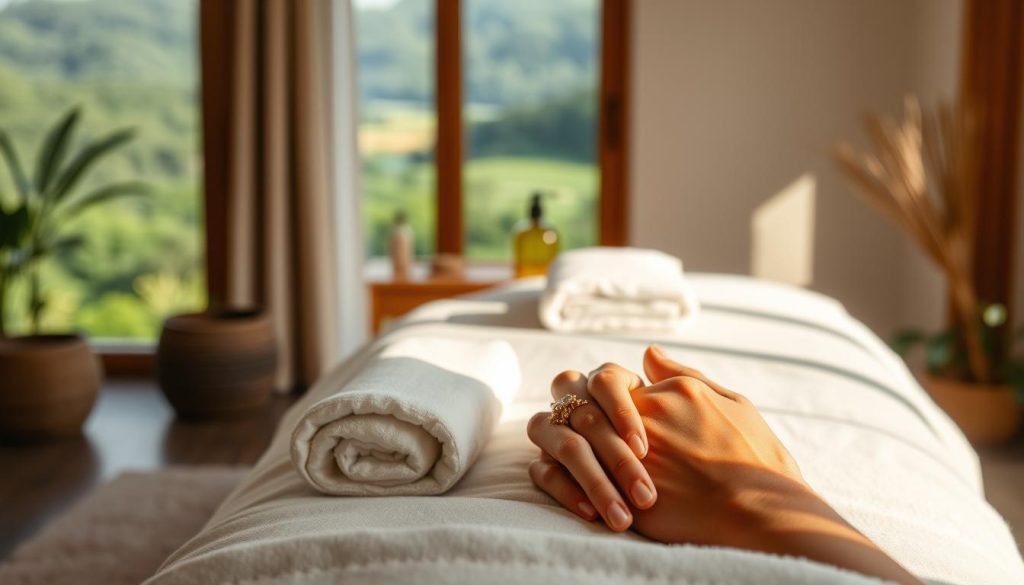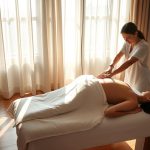Have you ever wondered how a few minutes of touch can transform your day? In today’s fast-paced world, finding ways to unwind and release tension is more important than ever. Whether you’re dealing with stress, muscle tightness, or just need a moment of relaxation, learning effective methods to care for your body can make all the difference.
Rachel Beider, a licensed therapist and CEO of PRESS, shares her expertise in *Press Here! Massage for Beginners*. This guide makes it easy for anyone to master methods like effleurage and kneading. These practices not only ease pain but also promote mental calmness. Plus, they’re perfect for solo sessions or shared moments with loved ones.
After your session, remember to stay hydrated. Drinking water helps flush out toxins and enhances the benefits of your efforts. Ready to take the first step toward a more relaxed you?
Key Takeaways
- Learn accessible at-home methods for stress relief.
- Reduce muscle tension and improve mental calmness quickly.
- Master beginner-friendly practices like effleurage and kneading.
- Enjoy these techniques solo or with a partner.
- Stay hydrated post-session to maximize benefits.
Why Simple Massage Techniques Are Effective for Stress Relief
Do you struggle with daily tension and need a natural way to unwind? Light strokes, like effleurage, can calm your nervous system. These gentle movements signal your body to relax, reducing stress and promoting a sense of calm.
Kneading, or petrissage, is another powerful method. It helps break up knots in your muscles and improves circulation. Better blood flow means more oxygen and nutrients reach your tissues, speeding up recovery and easing discomfort.
Studies show that regular sessions can lower heart rate and blood pressure. This makes it easier to focus and sleep better. The benefits extend beyond physical health, enhancing your mental well-being too.
Here’s a quick comparison of professional and home methods:
| Aspect | Professional Therapy | Home Techniques |
|---|---|---|
| Cost | $60-$120 per session | Free or minimal cost |
| Convenience | Requires scheduling | Anytime, anywhere |
| Effectiveness | High | Moderate to high |
Using these methods at home is not only cost-effective but also convenient. You can enjoy the benefits of relaxation without leaving your couch. Give it a try and see how it transforms your day!
Getting Started: Essential Tools and Preparation
Ready to create a calming space for your next session? Having the right tools and setup can make all the difference. Whether you’re a beginner or a seasoned massage therapist, preparation is key to a smooth experience.
Start by gathering essentials like hypoallergenic oils, soft towels, and a quiet space. These items help reduce friction and create a soothing atmosphere. A yoga mat or cushioned surface ensures comfort for both you and the receiver.

Before you begin, stretch your wrists and hands to prevent strain. Simple exercises like wrist rotations and finger stretches can improve flexibility and reduce fatigue during your practice.
Discuss pressure preferences with the receiver. Some prefer light strokes, while others enjoy deeper kneading. Starting with the legs is a safe way to practice strokes and build confidence.
Hygiene is equally important. Always ensure your hands are clean and nails are trimmed. This prevents discomfort and keeps the session pleasant for everyone involved.
Here’s a quick guide to the tools you’ll need:
| Tool | Purpose |
|---|---|
| Hypoallergenic Oil | Reduces friction and nourishes skin |
| Soft Towels | Provides warmth and absorbs excess oil |
| Quiet Space | Creates a relaxing environment |
For more tips on setting up your home practice, check out this ultimate guide. With the right tools and preparation, you’re ready to transform any area into a calming retreat.
Basic Hand Positions and Strokes for Beginners
Ever felt overwhelmed and wished for a quick way to relax? Learning basic hand positions and strokes can help you ease tension effectively. These techniques are beginner-friendly and require no special equipment.
Start with effleurage, a gliding stroke that preps your muscles. Use flat palms with light-to-medium pressure. Move in long, smooth movements along the body. This method is perfect for warming up and relaxing tight areas.
Next, try petrissage, a kneading technique that targets knots. Use your thumbs to make small circular motions on shoulders or calves. This helps release tension and improves blood flow.
For an invigorating effect, experiment with tapotement. This involves light tapping with your fingers or the edge of your hand. It’s great for stimulating muscles and boosting energy.
Finally, vibration techniques are ideal for sensitive areas. Gently shake or vibrate your hands over the skin. This can soothe nerves and promote relaxation.
For more detailed guidance, check out this essential guide on mastering the basics. With these strokes, you’ll be well on your way to creating a calming experience at home.
How to Perform a Relaxing Back Massage
Ever felt your back muscles tighten after a long day? A soothing session can help release tension and promote relaxation. Focus on the erector spinae, the muscles running along your spine, for maximum relief.
Start with effleurage, a gentle gliding motion from the lower to upper back. Use flat palms with light-to-medium pressure to warm up the areas. This technique prepares the muscles for deeper work.

Next, apply petrissage, a kneading method, along the spine. Avoid direct contact with bones to prevent discomfort. This helps break up knots and improves circulation, easing pain and stiffness.
For stubborn knots, try cross-fiber friction. Use your thumbs to apply firm, targeted pressure in a back-and-forth motion. This technique is highly effective for releasing deep tension.
Communication is key. Ask, “Is this pressure okay?” to ensure the receiver is comfortable. Adjust your approach based on their feedback for a personalized experience.
After the session, encourage the receiver to do light stretches. This enhances flexibility and prolongs the benefits of the massage. For more insights on how massage therapy can address health concerns, explore this guide.
Neck Massage Techniques for Muscle Knots
Are you dealing with persistent neck discomfort? Tightness in this area can lead to headaches, stiffness, and even pain. Learning how to release muscle knots in your neck can bring instant relief and improve your overall well-being.
Start with a seated self-massage. Use your fingertips or thumbs to trace small circles from the base of your skull to your shoulders. This gentle motion helps loosen tight muscles and reduces tension.
Focus on the trapezius, the large muscle that connects your neck and shoulders. Apply firm but gentle pressure with your thumbs, moving in circular motions. Avoid pressing directly on the spine to prevent discomfort.
For deeper relief, combine your routine with heat therapy. A warm towel or heating pad can relax muscles and enhance the effects of your self-massage. This is especially helpful for desk workers who often experience neck strain.
Here’s a quick guide to a 5-minute routine:
| Step | Action |
|---|---|
| 1 | Warm up with circular thumb motions. |
| 2 | Focus on the trapezius with firm pressure. |
| 3 | Apply heat for 2-3 minutes. |
| 4 | Finish with light strokes to relax. |
Regular practice can significantly reduce pain and improve flexibility. For more insights on effective methods to ease tension, explore this comprehensive guide. With these techniques, you’ll feel refreshed and ready to tackle your day!
Shoulder Massage: Combining Effleurage and Petrissage
Are your shoulders carrying the weight of the day? A blend of effleurage and petrissage can help you release strain and restore comfort. These methods are perfect for targeting tight muscles and promoting relaxation.
Start with effleurage, a gentle gliding stroke that warms up the shoulder blades. Use flat palms with light-to-medium pressure to prepare the area. This technique improves blood flow and reduces tension effectively.
Next, apply petrissage, a kneading method that lifts and rolls the deltoid muscles. This helps break up knots and relieves rotator cuff strain. For fibrous tissue, introduce “stripping,” a targeted technique that applies firm, linear pressure.
Adjust your approach based on the receiver’s needs. Athletes may require deeper pressure, while sedentary clients often prefer lighter strokes. Communication ensures a comfortable and effective session.
Here’s a quick guide to pressure adjustments:
| Client Type | Recommended Pressure |
|---|---|
| Athletes | Deep, firm strokes |
| Sedentary Clients | Light-to-medium strokes |
After the session, encourage hydration to reduce soreness. Drinking water flushes out toxins and enhances the benefits of your efforts. For more insights on effective shoulder relief, explore this detailed guide. With these methods, you’ll feel refreshed and ready to take on the day!
Foot Massage: Using Thumbs and Fingers for Relief
Your feet work hard—give them the care they deserve. A soothing session can relieve pain, improve circulation, and leave you feeling refreshed. Start by propping your feet on pillows for comfort and targeting reflexology points for maximum benefits.
Begin with arch relief. Use your thumbs to apply firm but gentle pressure along the arch. Move in small circles to release tension and promote relaxation. This method is especially helpful for those with plantar fasciitis.
Next, focus on the heels. Use your fingers to make circular motions, easing stiffness and discomfort. For added relief, try toe stretches. Gently pull each toe to improve flexibility and reduce tightness.
Enhance your routine with peppermint oil. Its cooling effect soothes tired feet and adds a refreshing touch. For individuals with diabetic neuropathy, consult your doctor before starting any new routine.
Regular sessions can reduce pain and improve overall well-being. For more insights on the benefits of massage therapy, explore this guide. With these methods, your feet will thank you!
Hand Massage: Simple Techniques for Daily Relaxation
Looking for a quick way to unwind after a long day? Your hands work tirelessly, and they deserve some care. A soothing session can ease stress, improve flexibility, and leave you feeling refreshed.
Start by applying a small amount of lotion to reduce friction. This makes the experience smoother and more enjoyable. Begin with palm kneading, a technique that helps relieve carpal tunnel discomfort. Use your thumbs to make small circular motions across the palm, applying gentle pressure.
Next, focus on your fingers. Gently pull each one from the base to the tip to release joint stiffness. This method is especially helpful for those who type or use their hands frequently. For added relief, try acupressure on the webbing between your thumb and index finger. Apply firm pressure for a few seconds to stimulate relaxation.
Short routines during work breaks can make a big difference. A 3-minute session can reduce tension and improve focus. Pair your routine with warm towels for enhanced relaxation. The heat helps loosen tight muscles and boosts the overall experience.
Here’s a quick guide to a 5-minute hand massage:
| Step | Action |
|---|---|
| 1 | Apply lotion and warm up with palm kneading. |
| 2 | Gently pull each finger to release stiffness. |
| 3 | Use acupressure on the thumb-index webbing. |
| 4 | Finish with warm towels for added comfort. |
Regular practice can significantly reduce stress and improve flexibility. For more insights on the benefits of hand care, explore this detailed guide. If you’re curious about how massage therapy compares to other relaxation methods, check out this comparison. With these techniques, your hands will feel rejuvenated and ready for anything!
Self-Massage: Techniques for Stress and Pain Relief
Feeling weighed down by daily stress? Discover how self-care can lighten your load. Self-massage is a powerful way to relieve pain and ease tension in your muscles. With a few tools and techniques, you can transform your home into a personal wellness retreat.
Start with a tennis ball for back knots. Place it between your lower back and a wall or the floor. Gently roll it over tight areas to release knots. For legs, a foam roller works wonders. Roll it along your calves and thighs to improve flexibility and reduce soreness.
For a seated lower-back release, try a lacrosse ball. Sit on it and move slowly to target deep muscles. This method is especially helpful for desk workers who experience chronic pain.
Don’t forget your scalp! Use your fingertips to apply gentle pressure in circular motions. This can ease tension headaches and promote relaxation. Pair it with deep breathing for maximum effect.
Wall-assisted calf stretches are another great option. Place your hands on a wall, step one foot back, and press your heel into the ground. Hold for 30 seconds to stretch tight calves.
If you’re new to self-massage, guided YouTube tutorials can be a lifesaver. They provide step-by-step instructions and ensure you’re using the right techniques.
Remember, avoid over-pressing bruised or sensitive areas. Listen to your body and adjust the pressure as needed. With these methods, you’ll feel refreshed and ready to tackle your day!
Safety Tips for Giving and Receiving Massages
Want to ensure your next session is both safe and effective? Whether you’re a massage therapistor practicing at home, understanding safety guidelines is essential. These tips will help you avoid discomfort and maximize the benefits of your experience.
First, be aware of contraindications. Avoid working on inflamed areas, varicose veins, or recent injuries. Conditions like fever, osteoporosis, or pregnancy require special care. Always consult a professional massage expert if you’re unsure.
Consent and comfort are key. Use towels for draping to ensure privacy and modesty. Check in regularly to confirm the pressure is comfortable. Too much force can cause pain or discomfort, especially in sensitive areas like the neck triangles.
After your session, prioritize rest. Avoid heavy workouts to let your body recover. Drinking water helps flush out toxins and enhances the benefits of your professional massage. Wait at least two hours before showering to allow the oils to fully absorb into your skin.
Here’s a quick guide to post-massage care:
| Action | Benefit |
|---|---|
| Rest | Promotes muscle recovery |
| Hydrate | Flushes out toxins |
| Wait to shower | Retains oil benefits |
For more insights on creating the perfect session, explore this detailed guide. With these safety tips, you’ll enjoy a worry-free and rejuvenating experience every time!
Conclusion: Embrace the Power of Simple Massage Techniques
Transform your daily routine with the power of touch. By mastering strokes like effleurage, petrissage, and tapotement, you can create moments of calm and relief. These methods are easy to incorporate into your day and require no special tools.
Commit to a daily 10-minute practice to experience lasting benefits. Whether you’re easing stress or improving flexibility, consistency is key. Remember to stay hydrated and follow aftercare tips to maximize the effects of your efforts.
For step-by-step guidance, explore *Press Here! Massage for Beginners*. This illustrated guide makes it easy to learn and apply these techniques at home. Your hands are your best tool—use them to create a sense of relaxation and well-being.
Discover how effective treatment for reducing stress can transform your life. Start today and feel the difference in your body and mind.






